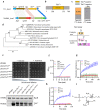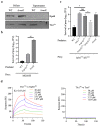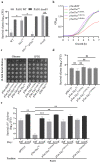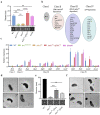The phospholipase effector Tle1Vc promotes Vibrio cholerae virulence by killing competitors and impacting gene expression
- PMID: 37526354
- PMCID: PMC10395195
- DOI: 10.1080/19490976.2023.2241204
The phospholipase effector Tle1Vc promotes Vibrio cholerae virulence by killing competitors and impacting gene expression
Abstract
Vibrio cholerae utilizes the Type VI secretion system (T6SS) to gain an advantage in interbacterial competition by delivering anti-prokaryotic effectors in a contact-dependent manner. However, the impact of T6SS and its secreted effectors on physiological behavior remains poorly understood. In this study, we present Tle1Vc, a phospholipase effector in atypical pathogenic V. cholerae E1 that is secreted by T6SS via its interaction with VgrG1E1. Tle1Vc contains a DUF2235 domain and belongs to the Tle1 (type VI lipase effector) family. Bacterial toxicity assays, lipase activity assays and site-directed mutagenesis revealed that Tle1Vc possessed phospholipase A1 activity and phospholipase A2 activity, and that Tle1Vc-induced toxicity required a serine residue (S356) and two aspartic acid residues (D417 and D496). Cells intoxication with Tle1Vc lead to membrane depolarization and alter membrane permeability. Tli1tox-, a cognate immunity protein, directly interacts with Tle1Vc to neutralize its toxicity. Moreover, Tle1Vc can kill multiple microorganisms by T6SS and promote in vivo fitness of V. cholerae through mediating antibacterial activity. Tle1Vc induces bacterial motility by increasing the expression of flagellar-related genes independently of functional T6SS and the tit-for-tat (TFT) response, where Pseudomonas aeruginosa uses its T6SS-H1 cluster to counterattack other offensive attackers. Our study also demonstrated that the physical puncture of E1 T6SS can induce a moderate TFT response, which is essential to the Tle1Vc-mediated strong TFT response, maximizing effector functions. Overall, our study characterized the antibacterial mechanism of phospholipase effector Tle1Vc and its multiple physiological significance.
Keywords: T6SS; Vibrio cholerae; motility; phospholipase effector; tit-for-tat.
Conflict of interest statement
No potential conflict of interest was reported by the author(s).
Figures








Similar articles
-
Pesticin-Like Effector VgrG3cp Targeting Peptidoglycan Delivered by the Type VI Secretion System Contributes to Vibrio cholerae Interbacterial Competition.Microbiol Spectr. 2023 Feb 14;11(1):e0426722. doi: 10.1128/spectrum.04267-22. Epub 2023 Jan 10. Microbiol Spectr. 2023. PMID: 36625646 Free PMC article.
-
A phospholipase A1 antibacterial Type VI secretion effector interacts directly with the C-terminal domain of the VgrG spike protein for delivery.Mol Microbiol. 2016 Mar;99(6):1099-118. doi: 10.1111/mmi.13292. Epub 2016 Feb 10. Mol Microbiol. 2016. PMID: 26714038
-
Identification of a new effector-immunity pair of Aeromonas hydrophila type VI secretion system.Vet Res. 2020 May 24;51(1):71. doi: 10.1186/s13567-020-00794-w. Vet Res. 2020. PMID: 32448355 Free PMC article.
-
T6SS intraspecific competition orchestrates Vibrio cholerae genotypic diversity.Int Microbiol. 2017 Sep;20(3):130-137. doi: 10.2436/20.1501.01.294. Int Microbiol. 2017. PMID: 29446804 Review.
-
The Vibrio cholerae type VI secretion system: toxins, regulators and consequences.Environ Microbiol. 2020 Oct;22(10):4112-4122. doi: 10.1111/1462-2920.14976. Epub 2020 Mar 13. Environ Microbiol. 2020. PMID: 32133757 Review.
Cited by
-
Transcriptomic profiling reveals RetS-mediated regulation of type VI secretion system and host cell responses in Pseudomonas aeruginosa infections.Front Cell Infect Microbiol. 2025 Jun 10;15:1582339. doi: 10.3389/fcimb.2025.1582339. eCollection 2025. Front Cell Infect Microbiol. 2025. PMID: 40557319 Free PMC article.
-
Mechanistic insights into the T6SS of multi-drug-resistant Aeromonas hydrophila and its role in competition and pathogenesis.mLife. 2025 Jul 22;4(4):363-377. doi: 10.1002/mlf2.70018. eCollection 2025 Aug. mLife. 2025. PMID: 40893974 Free PMC article.
-
The role of the type VI secretion system in the stress resistance of plant-associated bacteria.Stress Biol. 2024 Feb 20;4(1):16. doi: 10.1007/s44154-024-00151-3. Stress Biol. 2024. PMID: 38376647 Free PMC article. Review.
-
A bacterial membrane-disrupting protein stimulates animal metamorphosis.mBio. 2025 Feb 5;16(2):e0357324. doi: 10.1128/mbio.03573-24. Epub 2024 Dec 27. mBio. 2025. PMID: 39727418 Free PMC article.
-
RecA deletion disrupts protein homeostasis, leading to deamidation, oxidation, and impaired glycolysis in Cronobacter sakazakii.Appl Environ Microbiol. 2025 Jan 31;91(1):e0197124. doi: 10.1128/aem.01971-24. Epub 2024 Dec 31. Appl Environ Microbiol. 2025. PMID: 39745474 Free PMC article.
References
Publication types
MeSH terms
Substances
LinkOut - more resources
Full Text Sources
Miscellaneous
